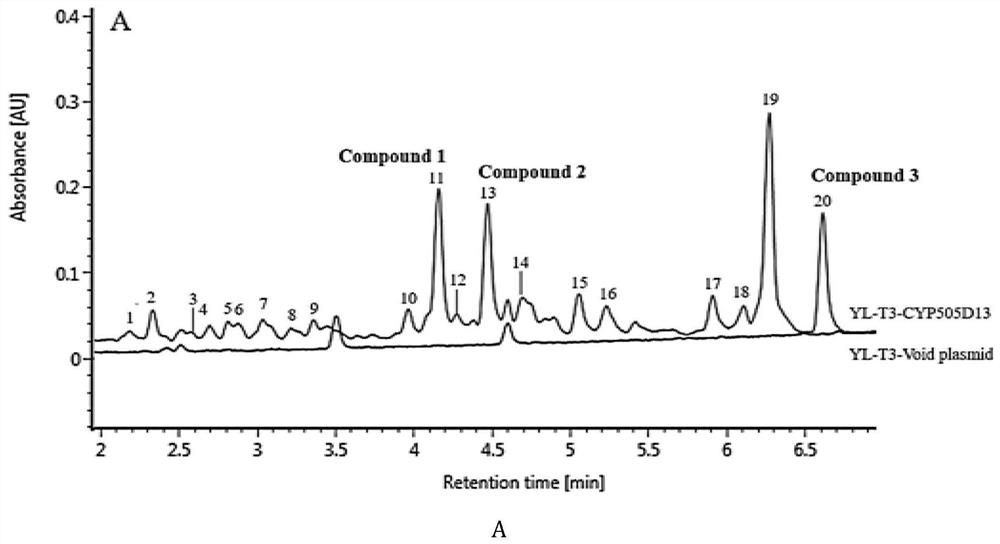Method for heterologous production of linear triterpenes
A linear and triterpenoid technology, applied in the field of bioengineering, can solve the problems of immature genetic manipulation and research lag
- Summary
- Abstract
- Description
- Claims
- Application Information
AI Technical Summary
Problems solved by technology
Method used
Image
Examples
Embodiment 1
[0029] Construction of recombinant yeast strains
[0030] Construction of yeast strains expressing CYP genes include:
[0031] Using the cDNA library of Ganoderma lucidum 5.616 as a template, the coding region sequence (CDS) fragment of cyp505d13 was obtained by PCR amplification with primer GL17184-F / R. The specific sequence of the primer is shown in Sequence Table 1;
[0032] The CDS fragments were then recombined into the expression vector pRS426 and verified by sequencing. The recombinant plasmid pRS426HF-cyp505d13 was obtained;
[0033] The recombinant plasmid was transformed into yeast strain YL-T3 to obtain yeast strain YL-T3-cyp505d13 expressing CYP gene.
[0034] Described recombinant plasmid pRS426HF-CYP17184 is obtained specifically in the following manner:
[0035] i) The pRS426 plasmid was linearized by SmaI followed by introduction of the yeast endogenous HXT7p promoter and FBA1t terminator at both ends.
[0036] Described HXT7p promoter and FBA1t terminator fr...
Embodiment 2
[0046] Product identification by fermentation of YL-T3-cyp505d13
[0047] YL-T3-cyp505d13 fermentation: 2.1) The constructed YL-T3-cyp505d13 yeast transformants were fermented in YPD medium (1% yeast powder, 2% beef peptone, 2% glucose), and the empty plasmid without CYP gene was used The strains were used as controls to compare the differences in metabolites between them. The specific operations were as follows:
[0048] 2.1.1) Fermentation culture of transformants. The positive transformants were inoculated into a 4mL SC-HLU seed culture test tube, cultured at 30°C and 220rpm for about 30h, and 1mL of the cultured seeds were aspirated, transferred to 50mL of YPD medium, and fermented at 30°C and 220rpm.
[0049] 2.1.2) On the 4th day of fermentation, take 20 mL of fermentation broth and add 20 mL of ethyl acetate and shake at 220 rpm for 30 min. Centrifuge at 5000rpm for 5min and absorb the upper organic phase, transfer to a rotary evaporator, spin dry ethyl acetate at 40°...
Embodiment 3
[0052] Fermentation product determination and dynamic accumulation process of yeast transformants
[0053] 3.1) High-performance liquid chromatography analysis method of fermentation product:
[0054] Instrument: Agilent 1200 analytical HPLC; Column: Agilent ZORBAX SB C18 reversed-phase column (5um, 4.6x250mm)
[0055] Column temperature: 30℃; flow rate: 1mL / min; injection volume: 20μL;
[0056] Phase A: methanol (containing 0.1% acetic acid), phase B: pure water;
[0057] Gradient elution program: initial phase A 80%, phase B 20%; 0-30 min, 80%-100% phase A; 30-40 min, 100% phase A. Detection wavelength 210nm.
[0058] 3.2) The transformed strain YL-T3-cyp505d13 containing CYP and the YL-T3 empty plasmid control bacteria were fermented in YPD medium, and the two strains grew (OD 600 ) and the dynamic process of product accumulation such as image 3 shown. YL-T3-cyp505d13 strain (solid line) and empty plasmid control strain YL-T3-Void plasmid (dashed line) grew similarly...
PUM
 Login to View More
Login to View More Abstract
Description
Claims
Application Information
 Login to View More
Login to View More - R&D
- Intellectual Property
- Life Sciences
- Materials
- Tech Scout
- Unparalleled Data Quality
- Higher Quality Content
- 60% Fewer Hallucinations
Browse by: Latest US Patents, China's latest patents, Technical Efficacy Thesaurus, Application Domain, Technology Topic, Popular Technical Reports.
© 2025 PatSnap. All rights reserved.Legal|Privacy policy|Modern Slavery Act Transparency Statement|Sitemap|About US| Contact US: help@patsnap.com



